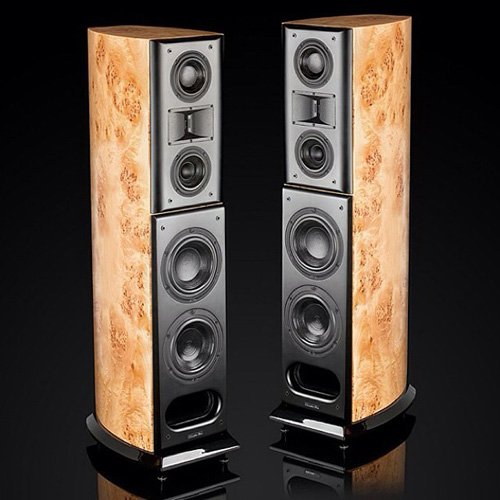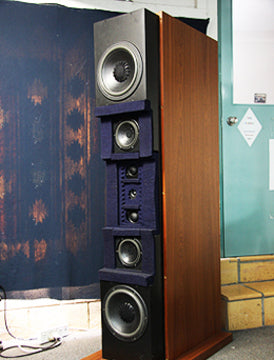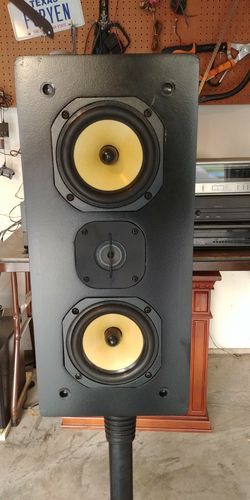https://bacheaudio.com/portfolios/sofia-102/Posted before, see my version D Appolito design whch i use in all Sofia line Loudspeakers
The D'Appolito, MTM Configuration
One speaker technology which is I think old but hasn't gotten the praise it deserves is the Joseph D'Appolito configuration. In short, it uses a tweeter vertically sandwiched between two midwoofers. Using two actual midranges is a variation on the theme.
What got me thinking of this was the $220,000 speaker pair that appeared on Stereophile's coverage of the Florida Audio Expo, which made me think, fondly, of the original, 1980's era Focal Utopia where I first heard this arrangement.
It's a very good arrangement for those who love detail and want a speaker that's relatively easy to live with.
How about you? Have a pair of D'Appolito-like speakers ever won you over?
I owned Duntech Sovereign speakers in the late 80's/early 90's these used this approach for all the drivers, but John Dunlavy used shadow first order crossovers. The big disadvantage of this design is that the tweeters had far less per handling capacity than the rest of the system and we're very easy to blow if you played them to loud.
|
I used to own a pair of the Aria 5 speaker kits back in the late 90’s. This was back when Focal still sold raw drivers to us DIY’s. These were probably the very first D’Appolito kits available. I built them from scratch. Not being a woodworker, my enclosures, while being acoustically sound, were not exactly the best looking. But I was actually somewhat ahead of my time, using inert tar like material (I wish I could remember what it was) with sand mixed in to coat the inside walls of the enclosure. Really deadened the box. This Stereophile article from 1990 says the kits were $600, about $1400 today, was a bargain back then. What I can remember about them, is, they had incredible detail. One would seriously have to spend several many times as much on a commercially available speaker to top them. And the same goes for soundstage and imaging. Nothing in the $600-$700 range at the time even came close.. I am still a DIY’r. and today, I believe building a DIY kit yields a speaker that sounds about as good as a commercially available speaker at about 5 times the $$. Back then, I think the margin was even greater. Maybe 8 times. These aren’t the ones I built, but they look similar.
|
Thanks for the extra info, @audiokinesis - I tried refreshing my memory via Wikipedia but it seemed woefully limited on details. Even the AES synopsis of his article seems to indicate he had much more to say about the interaction of driver arrangements, lobing and crossover slopes than what I put in my original post. For sure, without a horn / waveguide tweeter in the middle it seems hard to get the same tight vertical dispersion as the outer drivers, so using a simple dome tweeter seems to short-change the design. For those, besides Duke: Duke is pointing out that a simple MTM arrangement, using a dome T falls short of D'Appolito's design. In particular, the mids would have tight vertical dispersion, but the tweeter would have very wide vertical dispersion. Using a horn/waveguid would give similar vertical dispersion, and therefore reduce high frequency reflections (i.e. increase detail) and also sound smoother off-axis. The use of a horn also would seem to be a way to enable 4th order filters, thanks to the physical set-back of the driver. I must say that this is definitely one area where using an active / digital crossover can really make your life easy. |
Joseph D'Appolito's original design had a few characteristics which have not made it into everything "MTM". He used an odd-order crossover (3rd order), which would have a lobe at 45 degrees above the tweeter axis in a normal tweeter-on-top two-way configuration. With the MTM topology, we get one lobe above the tweeter axis and another lobe below the tweeter axis, resulting in significantly more uniform vertical coverage in the crossover region than we'd get with an even-order crossover. Also, the original tweeter was a horn-loaded Dynaudio dome, and the physical set-back of the tweeter's voice coil due to the horn depth contributed to time-alignment in the crossover region. Finally, the narrower radiation pattern of the horn-loaded tweeter resulted in better pattern-matching through the crossover region than we'd get with a conventional dome tweeter. The advantage of the more-commonly-used 4th order crossover for an MTM configuration is that it allows a lower crossover frequency, but along the way some of the desirable attributes of Joseph D'Appolito's exceptionally well-thought-out approach have been traded off. I've used an MHM format ("H" for horn tweeter) several times over the years, mostly in custom studio monitors. Duke |
@decooney, you nailed it, as I experience the same with the ProAcs. It is amazing how deep the sound stage goes behind the wall that is behind the speakers. |
I would agree with this assessment, and while I have tried other configurations where sound and stage went to the ceiling, what’s between my two MTM speakers now, and just to the outside of them on either side, the result produces amazing midrange and depth of stage. There is a cohesiveness in how the mids and high frequency blend together in a uniformed manner. Its just more engaging to me. Seeing more MTM configurations surfacing (or resurfacing) in the past year than I recalled seeing in prior years. Was just thinking about this recently, wondering why some design engineers just rediscovered this. Some of my original attempts were to essentially mimic the original Proac Response 3 speakers from a few decades ago. A good friend still enjoys my first set. For my 3rd built attempt I decided to pull the drivers even closer together. Some rough test mule cabinets helped get there, until making the final cabinets out of Walnut ply. I like the result more this way for this added cohesion i’m hearing. Don’t think I could ever go back to 2-ways or TMM/TWW. |
As I recall, while D'Appolito's early designs did not use 4th order filters he eventually came to the same conclusion.
I thought this was a feature, not a limitation. AFAIK, the idea was to narrow the vertical dispersion to minimize floor and ceiling reflections as much as possible, approaching some of the benefits of tall planar speakers or line arrays.
|
My current speakers are the Philharmonic BMR Towers which have a MTM array in the form of two balanced-mode-radiators flanking a RAAL ribbon tweeter. The MTM configuration can work well, but I think in most cases, steep crossover filters, ideally 4th-order, are a requisite, in order to prevent comb filtering. I’ve heard a few other MTM designs that didn’t have as good of coherence as one would expect. So as usual, it really comes down to the talent of the designer and implementation. Lots of ways to skin the proverbial cat. Also, MTMs are typically not capable of producing vertical dispersion as evenly as a coaxial design. I think all things being equal, coaxial designs (good ones) are often superior. |
@gdaddy1 - I meant to discuss the web site where they have several pages of news from the Florida show. :) In this particular case it was the Acora Acoustics VRC-1’s that made me think of all the speakers I’ve heard with this kind of arrangement, but they don’t need my help promoting them. :) I do like their choice in midrange though, since I use it in my center. :) I need to raise the prices! |
Yep, for the past 30 years. Three pairs of custom design and build, before I concluded this was it for me. Kept my last set, final build. No need for anything else. Love the sound. 👍 |




